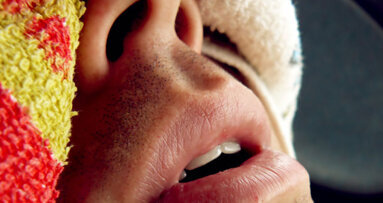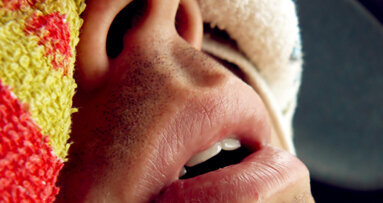WESTCHESTER, IL, USA: According to new research that received the Graduate Student Research Award at the 19th Annual Meeting of the American Academy of Dental Sleep Medicine, the ratio between tongue volume and bony enclosure size in patients with obstructive sleep apnea (OSA) may help dentists calculate oral appliance treatment success.
Although mandibular advancement splints (MAS) have been shown to be a safe and effective treatment for OSA, predicting efficacy in individual patients is problematic. The researchers assessed whether anatomical factors such as craniofacial size, upper-airway soft tissue volume, and/or the anatomical balance between them, were associated with MAS treatment outcome.
Each of the 49 patients in the study was fitted for a custom two-piece MAS, which was worn during sleep. Treatment outcome was assessed by polysomnography after approximately six weeks of oral appliance therapy. Twenty four responded to the treatment, demonstrating an apnea-hypopnea index (AHI) reduction of 50 per cent or more. Body mass index and age did not differ between responders and non-responders, but responders did have a lower baseline AHI, indicating that their sleep apnea was less severe before treatment.
Tongue cross-sectional area (CSA) was measured in a subset of 28 patients, including 12 responders and 16 non-responders. The measurements were taken using cephalometric soft-tissue imaging. Responders had a larger tongue CSA than non-responders, but there was no difference in the bony oral enclosure CSA. The ratio of tongue to bony enclosure CSA significantly differed between responders and non-responders, indicating the ratio as a significant predictor of response to treatment.
Because patients who responded to MAS treatment had a larger tongue volume for a given oral cavity size, the researchers suggest that determining this ratio may help predict MAS treatment success.
“While this study re-affirms the difficulties in predicting OSA treatment response to mandibular advancement splints, responders seem to have a larger tongue volume for a given oral cavity site, suggesting that MAS may help correct anatomical imbalances,” lead author Whitney Mostafiz concluded.
LEIPZIG, Germany: A new anti-leukaemia compound, currently being studied at the Albert Einstein College of Medicine of Yeshiva University in New York City ...
NEW YORK, N.Y., USA: Henry Schein Orthodontics has announced fall 2014 course dates for obstructive sleep apnea (OSA) courses. According to Henry Schein ...
BUFFALO, N.Y., USA: The best time to identify signs of obstructive sleep apnea may not be at night while snoozing in bed but, instead, while sitting in the ...
In an interview with Dental Tribune, Dr J. Brian Allman, founder of the TMJ Therapy and Sleep Center of Nevada, discusses obstructive sleep apnea (OSA) and ...
Obstructive sleep apnea may be linked to low bone mineral density in adults, according to University at Buffalo-led research. The findings are crucial for ...
NEW YORK, N.Y., USA: Despite the dosage recommendations that come with all drug packaging, not all recommendations are safe for everyone. The same is true ...
MELVILLE, N.Y. USA: On Monday health care products and service provider Henry Schein has launched an all-in-one solution for dentists to treat and monitor ...
MIAMI: The holiday season can be hard on one’s health, and people suffering from obstructive sleep apnea (OSA) feel it the most. Overeating and ...
Two-thirds of partnered adults say their other half snores, while six out of 10 of all adults (59 percent) say they snore. Sleep apnea may be present in 20 ...
NEW YORK CITY, NY, USA: It has been estimated that in the United States alone 20 million men, women and children suffer from obstructive ...
Live webinar
Mon. 1 December 2025
1:00 PM EST (New York)
Live webinar
Tue. 2 December 2025
12:00 PM EST (New York)
Dr. Petros Yuvanoglu D.M.D., Prosthodontist, Boston University / Tufts University, Dr. Robert Gottlander DDS
Live webinar
Tue. 2 December 2025
1:00 PM EST (New York)
Live webinar
Tue. 2 December 2025
8:00 PM EST (New York)
Dr. Magda Feres DDS, MSc, DMSc, Dr. Ira Lamster DDS, MMSc, Editor-in-Chief
Live webinar
Wed. 3 December 2025
6:00 AM EST (New York)
Luís Lourenço, Dr. Nokukhanya Makwakwa
Live webinar
Wed. 3 December 2025
9:00 AM EST (New York)
Live webinar
Wed. 3 December 2025
12:00 PM EST (New York)



 Austria / Österreich
Austria / Österreich
 Bosnia and Herzegovina / Босна и Херцеговина
Bosnia and Herzegovina / Босна и Херцеговина
 Bulgaria / България
Bulgaria / България
 Croatia / Hrvatska
Croatia / Hrvatska
 Czech Republic & Slovakia / Česká republika & Slovensko
Czech Republic & Slovakia / Česká republika & Slovensko
 France / France
France / France
 Germany / Deutschland
Germany / Deutschland
 Greece / ΕΛΛΑΔΑ
Greece / ΕΛΛΑΔΑ
 Hungary / Hungary
Hungary / Hungary
 Italy / Italia
Italy / Italia
 Netherlands / Nederland
Netherlands / Nederland
 Nordic / Nordic
Nordic / Nordic
 Poland / Polska
Poland / Polska
 Portugal / Portugal
Portugal / Portugal
 Romania & Moldova / România & Moldova
Romania & Moldova / România & Moldova
 Slovenia / Slovenija
Slovenia / Slovenija
 Serbia & Montenegro / Србија и Црна Гора
Serbia & Montenegro / Србија и Црна Гора
 Spain / España
Spain / España
 Switzerland / Schweiz
Switzerland / Schweiz
 Turkey / Türkiye
Turkey / Türkiye
 UK & Ireland / UK & Ireland
UK & Ireland / UK & Ireland
 International / International
International / International
 Brazil / Brasil
Brazil / Brasil
 Canada / Canada
Canada / Canada
 Latin America / Latinoamérica
Latin America / Latinoamérica
 China / 中国
China / 中国
 India / भारत गणराज्य
India / भारत गणराज्य
 Pakistan / Pākistān
Pakistan / Pākistān
 Vietnam / Việt Nam
Vietnam / Việt Nam
 ASEAN / ASEAN
ASEAN / ASEAN
 Israel / מְדִינַת יִשְׂרָאֵל
Israel / מְדִינַת יִשְׂרָאֵל
 Algeria, Morocco & Tunisia / الجزائر والمغرب وتونس
Algeria, Morocco & Tunisia / الجزائر والمغرب وتونس
 Middle East / Middle East
Middle East / Middle East




























































To post a reply please login or register